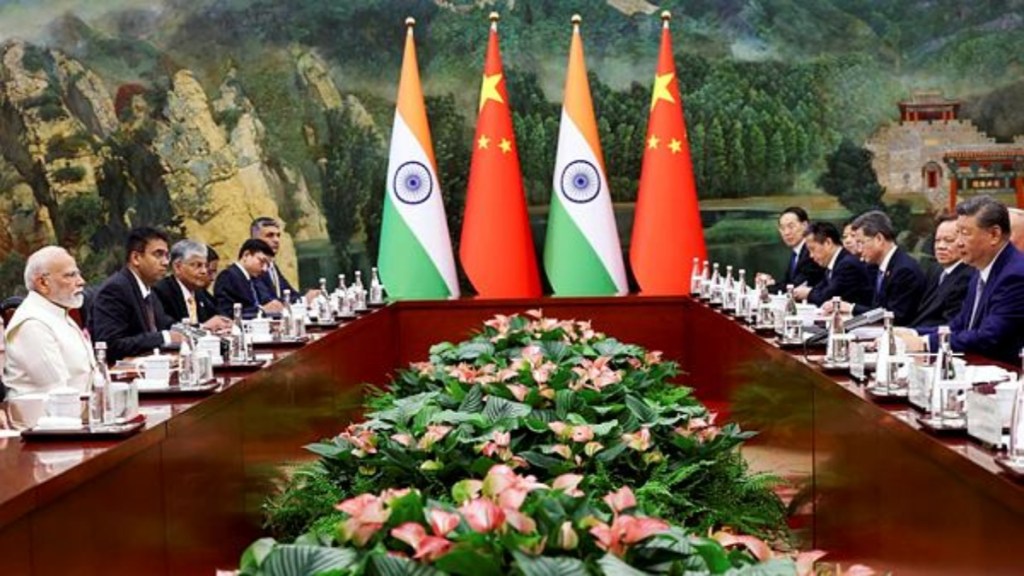India-China relation: Prime Minister Narendra Modi’s bilateral meeting with Chinese President Xi Jinping in Tianjin on Sunday, 31 August was a major development in the trajectory of India–China relations. Lasting 20 minutes longer than scheduled, the talks went beyond diplomatic protocol, reflecting substance rather than symbolism.
This was Prime Minister Modi’s first visit to China in seven years and his first bilateral meeting with Xi Jinping in the country since 2018. The discussions covered sensitive issues such as border management, trade, and civilisational cooperation. The meeting came against the backdrop of rising US tariffs on both India and China and amid Beijing’s leadership of the SCO. The symbolism of closer India–China cooperation will not go unnoticed in Washington.
President Xi underscored the importance of both countries as ancient civilisations, populous nations, and leaders of the Global South. He described India and China as the “dragon and the elephant” that must come together to promote peace, prosperity, and multipolarity.
“China and India are two ancient civilisations in the East. We are the world’s two most populous countries and also important members of the Global South. We both share the historical responsibility of improving the well-being of our two peoples, promoting solidarity and rejuvenation in developing countries, and advancing the progress of human society. It is the right choice for both countries to be friends who have good neighbourly and amicable ties, partners who enable each other’s success, and to have the dragon and the elephant come together,” Xi Jinping said.
PM Modi’s message
Modi recalled the constructive discussions with China at Kazan in 2024 and highlighted that border disengagement had created an atmosphere of peace and stability. He emphasised that the relationship should move forward on the principles of mutual trust, respect, and sensitivity, reiterating that cooperation between India and China affects not only 2.8 billion people directly but also global welfare.
He also thanked President Xi for inviting him to the SCO Summit and congratulated China on its successful chairmanship of the organisation.
Key takeaways from the Tianjin meeting
Border stability restored: Both leaders confirmed that their special representatives had reached a border management agreement, ensuring peace along contested frontiers. “The situation on the India-China Border is peaceful after disengagement,”said Prime Minister Narendra Modi.
Pilgrimage resumption: The Kailash Mansarovar Yatra will resume, marking a symbolic and cultural step towards confidence-building.
Direct flights restarting: Both sides agreed to restore direct air connectivity, strengthening people-to-people ties and business opportunities. Modi says, “An agreement has been reached between our Special Representatives regarding border management. Kailash Mansarovar Yatra has been resumed. Direct flights between the two countries are also being resumed. The interests of 2.8 billion people of both countries are linked to our cooperation. This will also pave the way for the welfare of the entire humanity. We are committed to taking our relations forward on the basis of mutual trust, respect and sensitivity.”
Civilisational emphasis: Xi highlighted that India and China share historical responsibility for the progress of the developing world, while Modi noted that bilateral cooperation supports humanity’s broader welfare.
Shared global south leadership: Both leaders pledged to uphold multilateralism, multipolarity, and democratisation of international institutions, reinforcing their commitment to a world order less dependent on Western dominance. “Its vital to be friends and good neighbours, India and China kust work together for peace in South Asia,” said Xi.
What Xi Jinping said?
In his opening statement, Xi Jinping underlined that 2025 marks the 75th anniversary of China–India diplomatic relations. He urged both sides to handle their ties from a strategic and long-term perspective, stressing that friendship and cooperation are the “right choice” for both nations.
Why Modi-Xi meeting matters
The Tianjin dialogue signalled a positive momentum in India–China relations, especially after years of strain following the 2020 Ladakh border clashes. By reaching agreements on border management, religious pilgrimage, and air links, the two countries demonstrated a willingness to move beyond confrontation.
The meeting also comes at a time of global realignment, with the United States increasingly hostile on trade and technology fronts. The optics of Modi and Xi projecting unity will likely unsettle Washington, which has sought to limit Beijing’s rise and deepen its own ties with New Delhi.
While challenges remain in trust-building and managing unresolved border disputes, the Tianjin meeting reflected a pragmatic approach by both leaders. The focus on cooperation within the SCO framework, regional stability, and economic engagement suggests that New Delhi and Beijing are prepared to chart a steadier course in their complex relationship.

